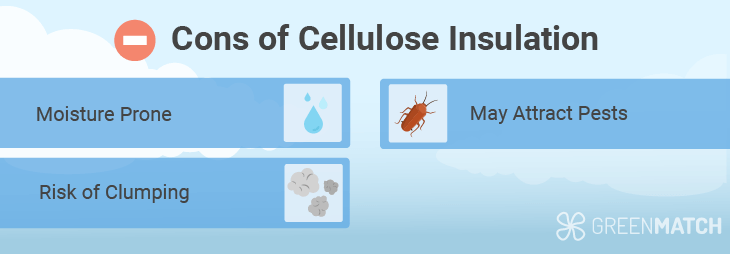Answer these simple questions and we will find you the BEST prices
Which type of solar quotes do you need?
It only takes 30 seconds
100% free with no obligation

Get Free quotes from insulation specialists near you

Save money by comparing quotes and choosing the most competitive offer

The service is 100% free and with no obligation
- GreenMatch
- Insulation
- Blown In Insulation
- Blown Cellulose Insulation
Your Complete Guide to Blown Cellulose Insulation


- Blown cellulose insulation is one of the most sustainable insulation materials, made nearly entirely from recycled paper products.
- Blown cellulose costs around £10 - £12 per m2 of material.
- This insulation material is most commonly used for loft, floor, or internal wall insulation.
Blown cellulose insulation is one of the most affordable, environmentally friendly and recyclable housing insulation materials out there, making it a high contender for all homes looking for insulation solutions.
With its ease of production and versatility, cellulose is commonly used as blown insulation for loft spaces, under floors, and behind stud walls for internal walls or even cavity wall insulation. Its favourable pricing balanced with decent thermal properties makes it a great budget-friendly insulation option for all homes alike.
This complete guide by GreenMatch UK will give you all the necessary information on blown cellulose, its pros, cons, costs and worth.
Want to insulate your home? Look no further than GreenMatch UK for a one-stop solution to all your needs. Instead of spending endless hours researching and vetting installers, just spend 30 seconds filling out our online form to receive up to 3 free home-tailored quotes. No charges or obligations apply. Click the button below to begin!
Fill in the form in just 1 minute
What is cellulose insulation?
Cellulose insulation is an innovative sustainable material that is made up of shredded paper products. This environmentally friendly material has impressive thermal properties, is very affordable and entirely recyclable.
Costing around £10 - £12 per m2, cellulose is marginally cheaper than most other insulation materials with similar thermal properties, making it a budget-friendly option for most.
Cellulose insulation is usually applied in two different ways; either as loose-fill or as blown insulation. Both approaches
- Loose-fill insulation: This is when bags of loose insulation cellulose are poured into the desired insulation area, such as underfloors.
- Blown-in insulation: This process requires a professional installer to blow cellulose into the area via industry equipment, which is most useful for hard-to-access spaces such as lofts or stud walls during internal wall insulation.
Benefits of blown cellulose insulation

Blown cellulose insulation stands out as one of the most popular insulation materials and with good reason. Its budget-friendliness, sustainability and high performance make it a handy material to work with.
Here are some advantages you can expect by installing blown cellulose insulation:
- Affordable: Cellulose insulation is relatively affordable in comparison to some other insulation materials, sitting at around £10 - £12 per m2.
- Environmentally friendly: Cellulose is an entirely recycled insulation, made from shredded waste paper and wood products that have been repurposed. This also makes it mostly biodegradable, as well as endlessly recyclable.
- High performance: Cellulose insulation has a surprisingly high r-value (2.4 - 2.8), meaning it is quite effective in resisting heat transfer. It is also relatively fireproof despite being made from paper and wood as it is usually treated with fire-retardant chemicals.
- Versatile use: Coming in the form of shredded material, cellulose insulation can be applied as loose-fill, or blown-in using professional equipment by an accredited installer.
Downsides of cellulose insulation

While the benefits of cellulose insulation are boundless, all materials come with their downsides. Here are some of the main problems associated with cellulose insulation:
- Moisture prone: As cellulose mainly comprises paper and wood products, it’s quite porous and prone to leeching moisture when exposed to dampness. For this reason, it's important to make sure the cavity in which the insulation is applied is fully sealed and airtight.
- Risk of clumping: Cellulose insulation is heavy and can clump and settle over time. This can create gaps in your insulation, causing cold spots and inefficient heat retention. A cellulose insulation top-up can fix this problem.
- May attract pests: Cellulose insulation can become a pest issue if not treated properly. Insects may nest in the blown cellulose, creating gaps and reducing the effectiveness of the insulation material.
Despite these issues, most of them are entirely avoidable by working with a professional installer. That way, you ensure that your insulation job is carried out by experts who know what they are doing. Proper blown cellulose insulation can last up to 20 - 30 years, making it all the more worthwhile to work with a professional installer.
Installing blown cellulose insulation
Blown cellulose insulation has to be installed by a professional using industry-specific equipment. However, the process is relatively fast and simple to carry out.
Here’s what you could expect:
- Preparation: A blown insulation installer will first make sure to seal any openings and air gaps. They will also prepare themselves with overalls, gloves and a breathing mask to ensure no particles are inhaled as this can irritate.
- Ventilation: Especially for loft insulation, an installer will create rafter vents on your roof to create a healthy flow of air. This will keep your cellulose insulation dry.
- Insulation: Once the space is prepared, an installer will use an industry machine and hose to blow cellulose material into the space until there is a healthy layer. If this is an underfloor, floorboards will be added back.
The process of insulation may differ depending on what part of your home you are insulating, as well as matters such as your specific home design, existing insulation, and personal preferences. For an accurate understanding of your situation, a home insulation check is highly recommended.
How much does cellulose insulation cost?
On average, cellulose insulation costs around £10 - £12 per m2. Your chosen manufacturer and type of cellulose, as well as labour costs and location, could influence your overall investment. Generally, a blown in insulation cost is on the more affordable end of the spectrum.
The main influencer of your overall cost will be what part of your home you are insulating; the loft, walls, floor or roof. Additionally, the size of the area that needs insulating matters, as larger areas cost more. For the most accurate prices, consult with a professional installer.
If the price tag adds up due to the size of your home, not all hope is lost. Luckily, two main government grant schemes help low-income, fuel-poor, and energy-inefficient households with insulation upgrades. These are the Great British Insulation Scheme (GBIS) and the Energy Company Obligation (ECO4).
A home insulation grant can help finance full or partial the cost of your cellulose fibre insulation, making it an easier cost to take on board.
Is cellulose insulation worth it?
As expected, blown cellulose is a worthy insulation investment for your home, especially when carried out by a professional installer. It is a highly sustainable, effective, and budget-friendly insulation material that can bring your home years of thermal comfort.
However, deciding to insulate your home is just the beginning. It’s just as important to work with a professional installer to ensure that the job is carried out correctly. Here are some of the benefits you can enjoy with an accredited installer:
- Avoid faulty installations: A trustworthy installer can be the fine line between decades of home comfort, or a shabby job in need of constant repair. Not only will this become a burdensome task, but can result in you having to entirely remove the insulation you just installed. Working with a professional can help avoid this.
- Find bargains: With the sea of installers out there, proper research and vetting can land you some pretty sweet deals. Many installers offer deals on combined insulation jobs, certain brands of insulation materials, season deals, and much more.
- Save money: All in all, not only can you potentially land nice bargains, but a professional high-quality installation will help you avoid unnecessary repair costs, and ensure a high-functioning job that saves you money on annual energy bills.
Finding the right installer can be quite a tedious process, requiring endless hours of online research and installer contacting. Luckily, GreenMatch UK can handle this for you.
Instead of spending countless hours of your life on the web, spend just 30 seconds filling out our online survey and receive up to 3 free home-tailored quotes from our network of pre-vetted installers. No charges and no obligations apply. Click the button below to begin!
Fill in the form in just 1 minute
FAQ
When installed properly, blown cellulose insulation can last a good 20 to 30 years. It’s important to work with a professional installer to ensure the job is done correctly and you get the most you can out of your investment.
Comprising of paper and wood products, cellulose insulation is particularly prone to moisture and dampness if poorly installed. As it is heavy, it can also clump over time, requiring an insulation top-up.
Cellulose insulation is a worthy investment, given its high sustainability, great performance, and ease of installation.
Loose-fill cellulose insulation is the same material used in blown-in cellulose insulation, but rather as loose particles sold in separate bags. These can be poured manually to top up insulation.
Cellulose insulation is an entirely sustainable, natural and safe material to use as insulation. It does not release harmful chemicals, off-gases or VOCs. However, it’s important to keep in mind the material comprises of paper and wood, meaning it is flammable and must be installed properly.

Akif is a copywriter at GreenMatch since 2023. With a keen interest in community sustainability, green solutions and the role of digital media in identifying climate trends, he aims to hone in on his background in International Studies and Digital Media to provide a multidisciplinary approach to written content rooted in credible research and accuracy.
We strive to connect our customers with the right product and supplier. Would you like to be part of GreenMatch?

